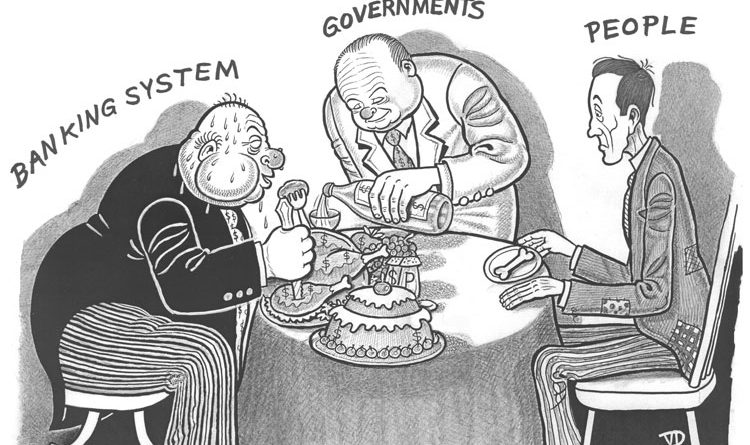Canadian Author Reveals the Clear Economic Solution to the Mass Migration Dilemma
TRUTH HOUND NOTE: Dissolving trade treaties such as the North American Free Trade Agreement would help Mexico and therefore reduce the incentive for Mexicans to abandon their homeland in search of so-called greener pastures in the U.S. In addition, ending the imperial Western-backed wars and scaling back America’s world policing would help stop the destruction of Syria, Yemen and other homelands from which people flee into the U.S. and Europe to save what’s left of their lives. But here is a far better insight into the overall mass migration problem which lends itself to an enduring “social credit” solution, as outlined by guest writer M. Oliver Heydorn of Canada. [Please scroll down for a link to the full article; any bold text represents the words of “Social Credit” conceiver Clifford H. Douglas. Heydorn heads the Douglas Institute and quotes him regularly]
By M. Oliver Heydorn, Ph.D [Go to the website www.socred.org to learn about Oliver’s important book, “Social Credit Economics.”]
We live now in an age of mass migrations and of rumours of mass migrations. With the term ‘mass migration’ we are referring, of course, to the movement, not merely of large numbers of people, but of whole groups of people, who constitute various racial-cultural gestalts, en masse from one nation or region to another. When it comes to explaining why this mass migration has been occurring, why it is, on the whole, a negative phenomenon, and what can be done to reduce migratory flows to saner proportions and saner forms, Social Credit theory has much to contribute to the public discourse.
The Economic Cause Behind Mass Migration
It has been commonplace to explain the existence of mass migration in the modern era in terms of technological advancements and particularly in terms of revolutions in communication and transport facilities, as though it were all a largely natural development. This overlooks the fact that a great deal of the more recent waves of mass migration, those with which we are most familiar, has actually been an effect of an international economic policy. Technology is what makes the mass migration possible, to be sure, but it really does not explain why it is happening. To this question of why, Social Credit provides an original and cogent answer.
The Social Credit analysis of cost reveals that the standard financial system is inherently unbalanced. It does not automatically provide the consumer with sufficient money in the form of income to offset the costs of production. This chronic lack or deficiency of consumer buying power means that the economy is also fundamentally unstable because it is, to a greater or lesser degree, structurally insolvent. In order to restore stability, the present economic model attempts to achieve an approximation of equilibrium by: a) borrowing into existence additional producer credit from the private banks in order to finance business expansion (especially for additional capital and export goods) or new government production, or else by: b) borrowing into existence additional consumer credit directly in the form of consumer loans. In both cases, the economy is committing itself to a programme of perpetual economic growth in order to keep itself afloat. Growth is mandated as the condition of the possibility of economic survival.
Countries that have been more or less successful in filling the price-income gap thus have a powerful incentive to steadily increase the populations within their borders so that their economies can continue to expand. If the native citizenry are not having a sufficient number of children to support the required level of growth, large numbers of additional producer-consumer units, otherwise known as human beings, must be ‘imported’ from the outside in order to maintain the economic momentum. At the same time, economically stagnant countries that have been less successful in bridging the gap, or even in just producing goods and services in the first place, are also provided with an incentive to export people for whom they cannot furnish an adequate livelihood. This releases some of the economic, social, and political pressure which those unemployed or under-employed citizens place upon their respective nations, and especially on whatever social services they may possess.
The Negative Character of Mass Migration
Respect for the organic, i.e., that which arises spontaneously from within, is a hallmark of Social Credit philosophy and policy. Social Credit’s great objection to mass migration and to the type of multicultural societies which mass migration produces is the thoroughly inorganic character of both. People do not fall prey to a spontaneous desire to permanently uproot themselves by journeying thousands of miles away from home, often inter-continentally, because they have an overwhelming wish to enrich someone else’s culture or for the love of travel.
They do it because the reigning financial system (amongst other possible factors) makes it difficult, if not extremely difficult, for many people to achieve a decent standard of living in their own countries of origin. The more well-to-do nations are all too eager to welcome these immigrants, who may be likened to ‘refugees’ fleeing financial oppression, as potential economic adjuncts. Provided that the money is forthcoming, these people will produce and above all consume, thus helping to satisfy the need for continual economic growth.
This forced movement of people creates a number of problems, however.
In the first place, it leads to the dilemma of integration. Throughout the world, and especially the Western world, different sorts of people are being forced to live in the same geographical space because of circumstances which have been imposed on all of them by external forces.
At the same time, societies must, by necessity, enjoy a certain degree of social cohesion in order to function. [1] But how do you successfully bind disparate people together who have no real common interests beyond the economic, which, under the existing system, is to say ‘money’? The two great models that have been developed to address the challenge of integration are the melting pot, typified by the United States, and the multicultural mosaic model, which some might say is typified by Canada.
The first policy attempts to dissolve individual cultural differences in the name of a common identity, while the second dissolves the common identity in the name of preserving individual cultural differences. Both policies are bound to fail; the first by denying or at least downplaying the incommunicability of organically derived cultures and the second by failing to meet the functional necessity of a society for a substantive common identity and bond. Both policies are policies of forced integration and forcing disparate groups of people to live together is utopian, i.e., out of step with reality:
Without carrying the German conception of Blut und Boden to the absurd lengths characteristic of its protagonists, only the type of mind which has absorbed the abstractions of Bloomsbury would dispute the large element of truth which it embodies. A nation is amongst other factors a culture, and while a culture probably contains many components which do not derive from the soil, it is certain that no culture which is not rooted in the soil and racially related to it has the character of permanence. [2]
To access the original article and read the rest of it, click on link below
http://www.socred.org/index.php/blogs/view/social-credit-and-mass-migration



